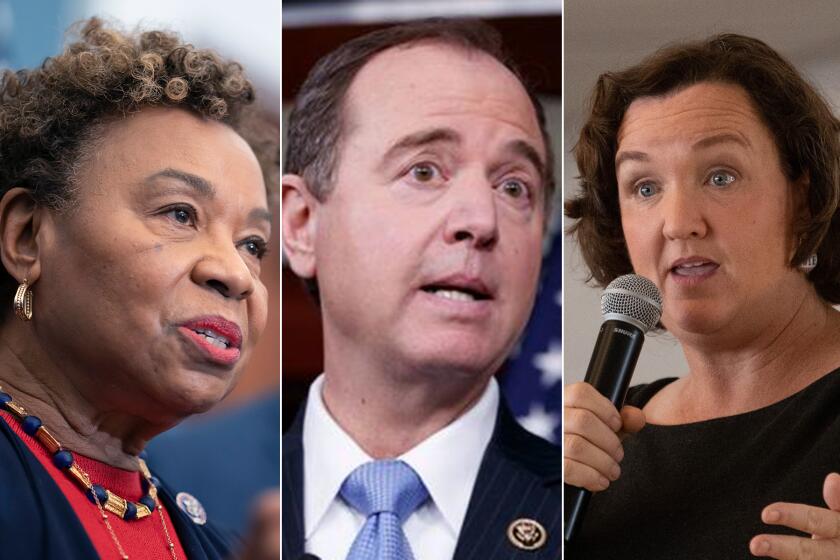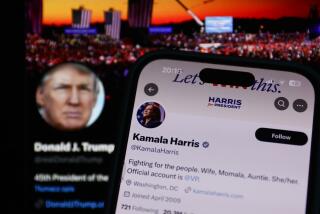Thousands of pro-Trump bots are attacking DeSantis and Haley on Twitter

- Share via
WASHINGTON — Over the last 11 months, someone created thousands of fake automated Twitter accounts — perhaps hundreds of thousands of them — to offer a stream of praise for former President Trump.
Besides posting adoring words about him, the fake accounts ridiculed his critics from both parties and attacked Nikki Haley, the former South Carolina governor and United Nations ambassador who is challenging her onetime boss for the 2024 Republican presidential nomination.
When it came to Florida Gov. Ron DeSantis, the bots aggressively suggested that he couldn’t beat Trump but would be a great running mate.
As Republican voters size up their candidates for 2024, whoever created the bot network is seeking to put a thumb on the scale, using online manipulation techniques pioneered by the Kremlin to sway Twitter’s conversation about candidates while exploiting the digital platform’s algorithms to maximize their reach.
The sprawling bot network was uncovered by researchers at Cyabra, an Israeli tech firm that shared its findings with the Associated Press. While the identity of those behind the network of fake accounts is unknown, Cyabra’s analysts determined that it was likely created within the U.S.
To identify a bot, researchers will look for patterns in an account’s profile, its follower list and the content it posts. Human users typically post about a variety of subjects, with a mix of original and reposted material, but bots often post repetitive content about the same topics.
Elon Musk and Tesla have millions of vocal fans on Twitter. Not all of them are real. Two researchers are trying to figure out who controls the bots.
That was true of many of the bots identified by Cyabra.
“One account will say, ‘Biden is trying to take our guns; Trump was the best,’ and another will say, ‘Jan. 6 was a lie and Trump was innocent,’” said Jules Gross, the Cyabra engineer who discovered the network. “Those voices are not people. For the sake of democracy I want people to know this is happening.”
Bots, as they are commonly called, are fake automated accounts that became notorious after Russia employed them in an effort to meddle in the 2016 presidential election. While big tech companies have improved their detection of fake accounts, the network identified by Cyabra shows that they remain a potent force in shaping online political discussion.
The new pro-Trump network is actually three different networks of Twitter accounts, all created in huge batches in April, October and November 2022. In all, researchers believe hundreds of thousands of accounts could be involved.
Though a blue state, California has lots of Republican voters, making it one of the biggest prizes in the GOP primary. How is the race shaping up?
The accounts all feature personal photos of the alleged account holder as well as a name. Some of the accounts posted their own content, often in reply to real users, while others reposted content from real users, helping to amplify it further.
“McConnell ... Traitor!” one of the accounts posted in response to an article in a conservative publication about GOP Senate leader Mitch McConnell (R-Ky.), one of several Republican critics of Trump targeted by the network.
One way of gauging the impact of bots is to measure the percentage of posts about any given topic generated by accounts that appear to be fake. The percentage for typical online debates is often in the low single digits. Twitter itself has said that less than 5% of its active daily users are fake or spam accounts.
When Cyabra researchers examined negative posts about specific Trump critics, however, they found far higher levels of inauthenticity. Nearly three-fourths of the negative posts about Haley, for example, were traced back to fake accounts.
Trump’s presence in the Republican presidential primary looms large and poses risks for a party seeking a unified front.
The network also helped popularize a call for DeSantis to join Trump as his vice presidential running mate — an outcome that would serve Trump well and allow him to avoid a potentially bitter matchup if DeSantis enters the race.
The same network of accounts shared overwhelmingly positive content about Trump and contributed to an overall false picture of his support online, researchers found.
“Our understanding of what is mainstream Republican sentiment for 2024 is being manipulated by the prevalence of bots online,” the Cyabra researchers concluded.
The triple network was discovered after Gross analyzed tweets about different national political figures and noticed that many of the accounts posting the content were created on the same day. Most of the accounts remain active, though they have relatively modest numbers of followers.
A message left with a spokesperson for Trump’s campaign was not immediately returned.
Most bots aren’t designed to persuade people but to amplify certain content so that more people see it, according to Samuel Woolley, a professor and misinformation researcher at the University of Texas, whose most recent book focuses on automated propaganda.
When a human user sees a hashtag or piece of content from a bot and reposts it, they’re doing the network’s job for it, and also sending a signal to Twitter’s algorithms to boost the spread of the content further.
Bots can also succeed in convincing people that a candidate or idea is more or less popular than he or she is in reality, Woolley said. More pro-Trump bots can lead to people overstating his popularity overall, for example.
House members like Adam Schiff and Katie Porter used to toil in relative anonymity. But viral videos and countless social media clicks have changed that for some celebrity lawmakers.
“Bots absolutely do impact the flow of information,” Woolley said. “They’re built to manufacture the illusion of popularity. Repetition is the core weapon of propaganda, and bots are really good at repetition. They’re really good at getting information in front of people’s eyeballs.”
Until recently, most bots were easily identified thanks to their clumsy writing or account names that included nonsensical words or long strings of random numbers. As social media platforms got better at detecting these accounts, the bots became more sophisticated.
So-called cyborg accounts are one example: a bot that is periodically taken over by a human user who can post original content and respond to users in human ways, making them much harder to sniff out.
Bots could soon get much sneakier thanks to advances in artificial intelligence. New AI programs can create lifelike profile photos and posts that sound much more authentic. Bots that sound like a real person and deploy deepfake video technology may challenge platforms and users alike in new ways, according to Katie Harbath, a fellow at the Bipartisan Policy Center and a former Facebook public policy director.
Ever since OpenAI’s viral chatbot was unveiled late last year, detractors have lined up to flag potential misuse of ChatGPT by email scammers, bots, stalkers and hackers.
“The platforms have gotten so much better at combating bots since 2016,” Harbath said. “But the types that we’re starting to see now, with AI, they can create fake people, fake videos.”
These technological advances likely ensure that bots have a long future in American politics — as digital foot soldiers in online campaigns, and as potential problems for both voters and candidates trying to defend themselves against anonymous online attacks.
“There’s never been more noise online,” said Tyler Brown, a political consultant and former digital director for the Republican National Committee. “How much of it is malicious or even unintentionally un-factual? It’s easy to imagine people being able to manipulate that.”
More to Read
Get our L.A. Times Politics newsletter
The latest news, analysis and insights from our politics team.
You may occasionally receive promotional content from the Los Angeles Times.







![Guitar heatmap AI image. I, _Sandra Glading_, am the copyright owner of the images/video/content that I am providing to you, Los Angeles Times Communications LLC, or I have permission from the copyright owner, _[not copyrighted - it's an AI-generated image]_, of the images/video/content to provide them to you, for publication in distribution platforms and channels affiliated with you. I grant you permission to use any and all images/video/content of __the musician heatmap___ for _Jon Healey_'s article/video/content on __the Yahoo News / McAfee partnership_. Please provide photo credit to __"courtesy of McAfee"___.](https://ca-times.brightspotcdn.com/dims4/default/f4350ab/2147483647/strip/true/crop/1600x1070+0+65/resize/320x214!/quality/75/?url=https%3A%2F%2Fcalifornia-times-brightspot.s3.amazonaws.com%2F60%2Fef%2F08cda72f447d9f64b22a287fa49c%2Fla-me-guitar-heatmap-ai-image.jpg)







